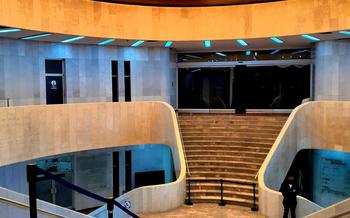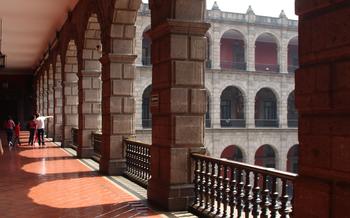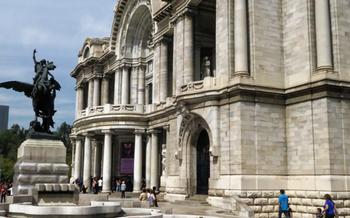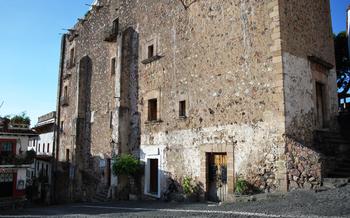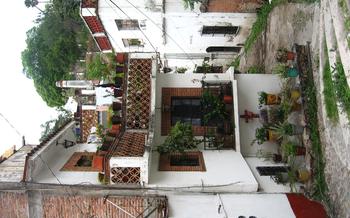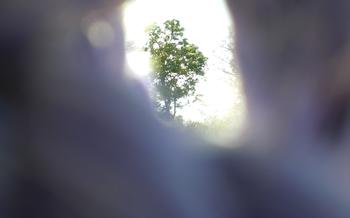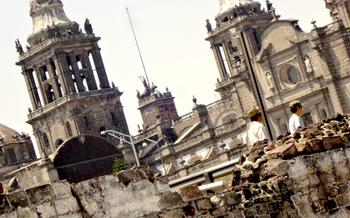
Taxco Cemetery
- Taxco Cemetery: A Monumental City of the Dead
- Exploring the Alleys and Streets of Taxco Cemetery
- Taxco Cemetery at Night: A Different Perspective
- Visiting the Church of Santa Prisca
- Paying Respects at the Grave of Juan O'Gorman
- Discovering the Mural by Diego Rivera
- Taxco Cemetery vs. Guanajuato Cemetery: A Comparison
- Tips for Visiting Taxco Cemetery
- Unforgettable Moments in Taxco Cemetery
- Taxco Cemetery: Beyond the Graves
- Incorporating Taxco Cemetery into Your Itinerary
- Capturing the Beauty of Taxco Cemetery
- Taxco Cemetery in Literature, Film, and Art
- Taxco Cemetery: A Source of Inspiration
- Insider Tip: Hidden Gems of Taxco Cemetery
Taxco Cemetery: A Monumental City of the Dead
The Taxco place that transcends its primary function as a burial ground. It is a historical landmark, an architectural marvel, and a cultural treasure that has captivated visitors for generations. Located in the heart of the picturesque colonial city of Taxco, Mexico, this cemetery is not just a place of reverence but also a vibrant testament to the region's rich artistic heritage and cultural traditions.
With its origins dating back to the 18th century, the Taxco Cemetery holds a significant place in the history of the region. It bears witness to the lives, struggles, and achievements of Taxco's inhabitants throughout the centuries. The cemetery's unique architectural styles, ranging from Baroque to Neoclassical, reflect the evolving artistic sensibilities of the era and showcase the skills of local artisans and craftsmen.
Beyond its architectural significance, the Taxco Cemetery holds immense cultural importance. It is a place where the living and the dead coexist in a harmonious embrace. Locals and tourists alike visit the cemetery to pay their respects to departed loved ones, celebrate life, and immerse themselves in the vibrant traditions associated with death and remembrance in Mexican culture.
Among the notable figures buried in the Taxco Cemetery is Juan O'Gorman, a renowned Mexican architect and artist best known for designing the National Museum of Anthropology in Mexico City. His grave, marked by a striking modernist sculpture, has become a pilgrimage site for admirers of his work and a reminder of his lasting legacy in Mexican architecture.
Exploring the Alleys and Streets of Taxco Cemetery
The Taxco Cemetery is not just a resting place for the dead but also a vibrant and lively neighborhood. Its narrow, winding cobblestone paths, which are adorned with colorful facades, are a delight to explore. Visitors can wander through the streets, discovering unique shops and galleries that sell a variety of items, from traditional Mexican crafts to modern art. The cemetery is also home to several restaurants and cafes, where visitors can relax and enjoy a meal or a cup of coffee while taking in the unique atmosphere. The Taxco Cemetery is a place where life and death intertwine, creating a vibrant and unforgettable experience for visitors.
Taxco Cemetery at Night: A Different Perspective
As the sun sets and darkness envelops the city, Taxco Cemetery transforms into a realm of tranquility and ethereal beauty. The winding cobblestone paths are illuminated by soft, flickering lights, casting an enchanting glow upon the intricate facades of the tombs. The once-bustling streets now exude a sense of peace and serenity, inviting visitors to wander amidst the silent witnesses of history.
During the evening hours, Taxco Cemetery takes on a completely different character. The daytime hustle and bustle give way to a tranquil ambiance, perfect for quiet contemplation and reflection. Visitors can stroll along the illuminated paths, admiring the intricate details of the mausoleums and crypts, each one a testament to the lives and legacies of the departed.
For those seeking a unique and memorable experience, Taxco Cemetery offers a variety of nighttime activities. Guided tours led by local historians provide fascinating insights into the cemetery's history, architecture, and cultural significance. Visitors can also participate in candlelight processions or attend special events such as concerts or art exhibitions held within the cemetery grounds.
While Taxco Cemetery is generally safe to visit at night, it is advisable to exercise caution and be aware of your surroundings. Stick to well-lit areas, and avoid venturing into secluded corners alone. It is also recommended to inform your hotel or tour operator about your plans to visit the cemetery at night, especially if you intend to stay until late.
Visiting the Church of Santa Prisca
At the heart of Taxco Cemetery lies the magnificent Church of Santa Prisca, an architectural masterpiece that serves as a testament to the city's rich colonial heritage. Constructed in the Baroque style, this iconic church boasts an elaborate facade adorned with intricate carvings, sculptures, and reliefs that narrate biblical stories and depict scenes from the lives of saints.
The interior of the church is equally captivating, showcasing stunning frescoes, opulent gold leaf decorations, and a majestic altar that commands attention with its grandiose design. Visitors can admire the intricate details of the vaulted ceilings, where masterful brushstrokes bring to life religious scenes and celestial imagery.
Beyond its aesthetic allure, the Church of Santa Prisca holds deep religious significance for the people of Taxco. It serves as a place of worship, a sanctuary for spiritual contemplation, and a symbol of the city's deep-rooted Catholic faith. Throughout the year, the church hosts various religious ceremonies, festivals, and processions that draw both locals and pilgrims from afar.
Paying Respects at the Grave of Juan O'Gorman
Among the notable figures laid to rest in Taxco Cemetery is the renowned Mexican architect Juan O'Gorman (1905-1982). O'Gorman was a prominent figure in the 20th-century architecture movement known as Mexican Functionalism. He is best known for designing the National Museum of Anthropology in Mexico City, a masterpiece of modern architecture that showcases pre-Hispanic and colonial Mexican artifacts.
O'Gorman's grave in Taxco Cemetery is a simple yet elegant affair, reflecting his humble and understated personality. A white marble headstone bears his name, dates of birth and death, and a brief epitaph that reads, "Architect of the National Museum of Anthropology."
Visiting O'Gorman's grave is a pilgrimage of sorts for architecture enthusiasts and admirers of his work. It is a chance to pay respects to a visionary architect who left an indelible mark on Mexican architecture and to reflect on his legacy.
The location of O'Gorman's grave is in Section 3 of the cemetery, near the main entrance. It is easily identifiable by the white marble headstone and the often-present offerings of flowers and candles left by his admirers.
Discovering the Mural by Diego Rivera
Within the confines of the Taxco Cemetery lies a hidden gem, a testament to the artistic prowess of one of Mexico's most celebrated muralists, Diego Rivera. In the Chapel of the Holy Sepulcher, nestled among the hallowed grounds, visitors can marvel at a striking mural that encapsulates the essence of the Day of the Dead.
Rivera's unique style, characterized by bold lines, vibrant colors, and a deep connection to Mexican culture, comes alive in this masterpiece. The mural depicts a lively scene, teeming with skeletal figures engaged in various activities, from feasting and dancing to playing musical instruments.
The Day of the Dead, a significant Mexican tradition, is a celebration of life and remembrance, blurring the lines between the living and the departed. Rivera's mural captures the essence of this joyous occasion, honoring the memory of those who have passed while embracing the continuity of life.
The historical context of the mural adds depth to its significance. Created in the 1950s, during a period of social and cultural transformation in Mexico, Rivera's artwork served as a poignant reminder of the country's rich traditions and indigenous heritage.
Today, the mural stands as a testament to Rivera's enduring legacy and his commitment to preserving Mexican identity. Visitors to Taxco Cemetery are granted a rare opportunity to witness this masterpiece up close, immersing themselves in the vibrant colors and intricate details that bring the Day of the Dead to life.
Taxco Cemetery vs. Guanajuato Cemetery: A Comparison
The Taxco Cemetery and the Guanajuato Cemetery are two of the most iconic cemeteries in Mexico, each with its unique characteristics and historical significance. While both cemeteries share similarities in their rich cultural heritage and architectural styles, there are also distinct differences that set them apart.
In terms of architectural styles, the Taxco Cemetery is known for its colonial baroque style, with its whitewashed facades, intricate carvings, and colorful domes. On the other hand, the Guanajuato Cemetery is renowned for its neoclassical style, characterized by its symmetrical design, Doric columns, and elegant sculptures.
Culturally, both cemeteries hold great importance as they are integral parts of the local communities and play a significant role in the celebration of the Day of the Dead. However, the Taxco Cemetery is more closely associated with the indigenous traditions of the region, while the Guanajuato Cemetery is more influenced by European customs and traditions.
Regarding the tourist experience, the Taxco Cemetery offers a more intimate and serene atmosphere due to its smaller size and location in a tranquil neighborhood. In contrast, the Guanajuato Cemetery is larger and more popular with tourists, offering a more lively and vibrant atmosphere.
Ultimately, the choice between visiting the Taxco Cemetery or the Guanajuato Cemetery depends on personal preferences and interests. If you seek a more tranquil and culturally immersive experience, the Taxco Cemetery is an excellent choice. If you prefer a larger and more lively cemetery with a mix of architectural styles and cultural influences, the Guanajuato Cemetery is a great option.
Tips for Visiting Taxco Cemetery
Dress Code: Taxco Cemetery is a place of respect and reverence, so visitors should dress appropriately. Avoid wearing shorts, tank tops, or revealing clothing, as these may be considered disrespectful.
Respectful Behavior: While exploring the cemetery, visitors should be mindful of their behavior. Keep noise levels low, avoid disturbing the peace of those who are paying their respects, and do not climb on or touch the graves or monuments.
Photography Guidelines: Photography is generally allowed in Taxco Cemetery, but visitors should be respectful of the privacy of others. Avoid taking photos of people without their permission, and be mindful of the emotional state of those who may be grieving.
Best Time to Visit: The best time to visit Taxco Cemetery is during the late afternoon or early evening, when the sun is lower and the shadows create a unique and atmospheric ambiance.
Unforgettable Moments in Taxco Cemetery
Taxco Cemetery holds a special place in the hearts of its visitors, leaving an indelible mark on their souls. One such memorable moment occurred during my visit to the resting place of Juan O'Gorman, the renowned Mexican architect and designer of the National Museum of Anthropology. As I stood before his grave, contemplating his extraordinary life and legacy, a profound sense of awe washed over me. Here, in this tranquil space, I felt a tangible connection to a man whose creative genius had shaped the cultural landscape of Mexico.
Another unforgettable moment unfolded during a Dia de los Muertos celebration in the cemetery. Amid the vibrant colors, music, and offerings adorning the graves, I witnessed the heartfelt rituals as families and friends gathered to honor their departed loved ones. The cemetery transformed into a stage of life and remembrance, where the veil between the living and the dead seemed to dissolve, creating a profound and moving experience.
In the embrace of the night, I stumbled upon a hidden corner of the cemetery, where the grave of a young woman named Maria stood out. Her tombstone recounted a tragic love story, leaving me deeply affected by her untimely demise. The poignant inscription on her grave served as a poignant reminder of the transient nature of life and the enduring power of love.
Taxco Cemetery is a place that transcends the boundaries of life and death, where stories are told, emotions are stirred, and connections are formed. Each visit unravels a tapestry of memories and experiences that linger long after departure, making it a destination that stays etched in the traveler's heart.
Taxco Cemetery: Beyond the Graves
The Taxco Cemetery is not only a resting place for the deceased but also a vibrant venue for cultural events and community gatherings. Throughout the year, the cemetery hosts a variety of events that celebrate the rich history and traditions of Taxco.
One of the most significant events is the annual Day of the Dead celebration. During this time, families gather at the cemetery to honor their departed loved ones by decorating their graves with colorful flowers, candles, and offerings of food and drinks. The cemetery comes alive with music, laughter, and the sharing of stories and memories.
In addition to the Day of the Dead, the Taxco Cemetery also hosts art exhibitions, concerts, and historical reenactments. These events provide visitors with a unique opportunity to experience the cemetery's cultural significance and connect with the local community.
The cemetery is also a popular spot for weddings and other special events. Its picturesque setting and historic ambiance create a magical backdrop for these celebrations.
Whether you are interested in history, culture, or simply seeking a unique and memorable experience, the Taxco Cemetery is a must-visit destination.
Incorporating Taxco Cemetery into Your Itinerary
To fully appreciate the beauty and significance of Taxco Cemetery, consider setting aside at least half a day for your visit. Allow yourself ample time to wander through the alleys, admire the architecture, and soak in the unique atmosphere.
Suggested walking routes: - Start your exploration at the main entrance on Calle del Cementerio. - Follow the winding cobblestone paths, taking note of the intricate facades and colorful decorations. - Descend into the lower levels of the cemetery, where you'll find older and more elaborate tombs. - Make your way to the Church of Santa Prisca, located at the highest point of the cemetery, for stunning views of the city.
Nearby attractions: - Visit the nearby Plaza Borda, a lively square with restaurants, shops, and street performers. - Explore the historic center of Taxco, with its colonial architecture and charming boutiques. - Take a cable car ride to the Cristo Rey Monument for panoramic views of the city and surrounding mountains.
Transportation options: - Taxco is easily accessible by bus or car from Mexico City and other major cities. - Taxis and local buses are readily available for getting around town. - Consider booking a guided tour for a more in-depth exploration of the cemetery and its history.
Tour recommendations: - Guided tours are offered by local guides and tour companies. - Tours typically cover the history, architecture, and cultural significance of the cemetery. - Private tours can be arranged for a more personalized experience.
Capturing the Beauty of Taxco Cemetery
Taxco Cemetery presents a wealth of opportunities to capture stunning photographs. Its unique architecture, vibrant colors, and intricate details make it a paradise for photographers of all skill levels. To fully capture the essence of this extraordinary place, here are some tips to help you create captivating images:
-
Embrace Natural Lighting: The best time to photograph Taxco Cemetery is during the golden hours of sunrise and sunset when the warm light casts a magical glow on the colorful facades and cobblestone streets.
-
Experiment with Angles: Don't be afraid to explore different perspectives. Look for interesting angles that showcase the cemetery's unique features, such as the winding paths, ornate tombstones, and panoramic views.
-
Compose Your Shots: Pay attention to composition techniques to create visually appealing images. Incorporate leading lines, rule of thirds, and depth of field to add interest and depth to your photographs.
-
Tell a Story: Your photographs should not only be aesthetically pleasing but also convey a story. Capture the emotions, interactions, and cultural significance of Taxco Cemetery through your images.
-
Use a Tripod: A tripod is essential for capturing sharp and steady shots, especially in low-light conditions. It allows you to use slower shutter speeds to capture the movement of people or the subtle details of the cemetery's architecture.
-
Edit Thoughtfully: After capturing your images, take the time to edit them carefully. Use photo editing software to adjust exposure, contrast, and colors to enhance the visual impact of your photographs.
Taxco Cemetery in Literature, Film, and Art
The mystique and allure of Taxco Cemetery have captivated the imaginations of artists, writers, and filmmakers for centuries. In literature, the cemetery has been immortalized in the works of renowned Mexican authors such as Carlos Fuentes and Juan Rulfo, who wove its haunting beauty into their stories of love, loss, and redemption.
On the silver screen, Taxco Cemetery has served as a backdrop for numerous Mexican and international films, including "Frida" (2002), a biopic about the life of the iconic artist Frida Kahlo, and "The Mask of Zorro" (1998), a swashbuckling adventure set in 19th-century Mexico.
Beyond literature and film, Taxco Cemetery has also inspired countless works of art. Mexican muralist Diego Rivera, known for his vibrant depictions of Mexican history and culture, created a stunning mural in the Chapel of the Holy Sepulcher within the cemetery, showcasing his unique style and reverence for the Day of the Dead.
These cultural representations not only pay homage to the beauty and significance of Taxco Cemetery but also contribute to its enduring legacy as a place of inspiration and cultural exchange.
Taxco Cemetery: A Source of Inspiration
Taxco Cemetery has been an enduring source of inspiration for artists, writers, and musicians from around the world. Its unique atmosphere, captivating history, and stunning visuals have sparked creativity and fueled artistic expression in various forms.
Painters and photographers have been drawn to the cemetery's picturesque landscapes, capturing its intricate details and vibrant colors on canvas and through the lens. Its haunting beauty and serene ambiance have served as muses for poets and novelists, who have penned poignant verses and captivating tales inspired by the cemetery's stories.
Musicians have found solace and inspiration within the cemetery's walls, composing melodies that reflect the emotions and experiences associated with death and remembrance. The cemetery's unique acoustics and reverberant atmosphere have created a natural stage for musical performances, transforming it into a space where art and spirituality converge.
Taxco Cemetery has also been a catalyst for cultural exchange and collaboration. Artists from different backgrounds and disciplines have come together to create immersive installations, performances, and exhibitions that explore the themes of life, death, and the afterlife. These collaborative projects have fostered a sense of community and understanding among artists and audiences alike.
The cemetery's rich history and cultural significance have made it a valuable resource for researchers and scholars. Historians, anthropologists, and sociologists have delved into its past, uncovering stories of the people buried there and examining the cemetery's role in shaping Taxco's identity. Their work has contributed to a deeper understanding of Mexican culture and history.
Beyond individual artistic endeavors, Taxco Cemetery has played a crucial role in preserving and promoting Mexican heritage. It serves as a living museum, showcasing the country's artistic traditions, architectural styles, and cultural practices. By honoring the dead, the cemetery also honors the living, ensuring that their stories and legacies continue to be remembered and celebrated.
Insider Tip: Hidden Gems of Taxco Cemetery
Beyond the famous landmarks and well-known paths, Taxco Cemetery holds secret corners and hidden gems waiting to be discovered by curious travelers. Explore the lesser-known areas and uncover unique monuments that tell stories of forgotten times. Seek out the secluded gardens and quiet courtyards that offer moments of tranquility and reflection. Discover the secret spots where locals gather to share stories and memories of their departed loved ones. Venture off the beaten path and you may find yourself in front of a hidden chapel, a weathered statue, or an inscription that reveals a forgotten piece of history. These hidden treasures add depth and intrigue to your visit, making Taxco Cemetery more than just a place of remembrance, but a place of exploration and discovery.


